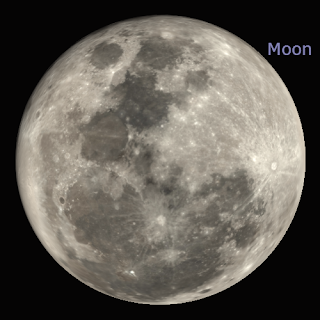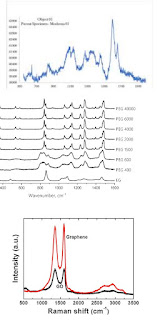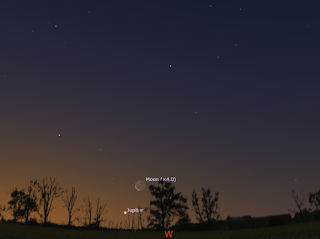Monday, February 21, 2022
Thursday February 24 to Thursday March 3
The Last Quarter Moon is Thursday, February 24, the New Moon is Thursday March 3. Mars is readily visible in the morning sky just above bright Venus with Mercury below. On the 27th and 28th the crescent moon close to the pair. During the week Mercury leaves Mars and Venus behind and sinks towards the horizon, as Saturn rises to meet it. On March 1 Mercury Saturn and the thin crescent Moon are close. On the 3rd Mercury and Saturn are very close, fitting within a medium power telescope eye piece.
The Last Quarter Moon is Thursday, February 24, the New Moon is Thursday March 3. The Moon is at perigee, when it is closest to the Earth, on the 27th.

Similar views will be seen from the rest of Australia at the equivalent local time (90 minutes before sunrise, click to embiggen).
Similar views will be seen from the rest of Australia at the equivalent
local time (60 minutes before sunrise, click to embiggen).
Similar views will be seen from the rest of Australia at the equivalent
local time (60 minutes before sunrise, click to embiggen). the inset shows the approximate binocular view of the pair.
Elsewhere
in Australia will see a similar view at the equivalent
time (90 minutes after sunset).
Mercury forms a triangle with the pair of Venus and Mars at the beginning of the week. During the week Mercury leaves Mars and Venus behind and sinks towards the horizon, as Saturn rises to meet it. On March 1 Mercury Saturn and the thin crescent Moon are close. On the 3rd Mercury and Saturn are very close, fitting within a medium power telescope eye piece.
Venus is rising in the morning twilight towards Mars.
Star Map via Virtual sky. Use your mouse to scroll around and press 8 when your pointer is in the map to set to the current time.
Cloud cover predictions can be found at SkippySky.
Here is the near-real time satellite view of the clouds (day and night) http://satview.bom.gov.au/
Labels: weekly sky
Wednesday, February 16, 2022
2022: From "Super" Moon to "Mini" Moon and back, a year of full Moons
| Full Moon January 18, 21:00 AEST. Apogee 12th. | Full Moon February 17 FM 3:08 AEST Maximum libration 3:00 pm | Full Moon March 18 FM 17:00 AEST. |
| Full Moon April 17 05:00, AEST | Full Moon May 16 14:00 AEST, perigee May 18 1 am (+1d11h) | Full Moon June 14 22:00 AEST, perigee June 15 09:00 +11h |
| Full Moon July 14 05:00 AEST. perigee July 13 19:00 (-9h, closest this year) | Full Moon August 12 12:00 AEST. Perigee 11th 3am | Full Moon September 10 20:00 AEST.maximum libration 6 am 11th. |
| Full Moon October 10 07:00 AEST, | Full Moon November 8 21:00, Total Lunar eclipse, eclipse max 20:59 AEST | Full Moon December 8 14:00 AEST Moon at apogee 12th +3d20h |
A year of full Moons showing the variation in size as the moons move from perigee to apogee. All the moons are shown on the day and time (AEST) they are full (unless they are below the horizon, in which case the size at astronomical twilight is shown), and although this is not the optimal time for size comparisons, you can clearly see the size difference over the year (compare July 14 to December 8) the original scale for all is 2 degrees of field of view cropped down). Although the field rotation of the Moon makes it less clear, you can also see the effect of libration.
In 2022 we have two good Perigee Moon is a row (June 15, July 14). However, as you can see the differences are subtle, and it requires a keen eye and good memory to distinguish a perigee "super" Moon from more ordinary moons, the best contrast is with the apogee "mini" moon of December 8, even though this is not a good apogee Moon).
That doesn't mean you shouldn't try though. Daniel Fischer has been able to see the difference, you can read
his account and viewing tips here
http://earthsky.org/space/can-you-discern-supermoons-large-size-with-the-eye-an-observer-says-yes
Photographing them can be more rewarding. You can see images of perigee Moon and apogee Moon pairs from 21 Jan 2019 here and 10 August 2014 here.Tips for photographing them are here.
There is also a Total Lunar eclipse on November 8 in the early evening, with eastern and central states favored.4
Labels: apogee, Moon, perigee, public outreach, Yearly Moons
Tuesday, February 15, 2022
Thursday February 17 to Thursday February 24
The Full Moon is Thursday, February 17, the Last Quarter Moon is Thursday, February 24. On the 24th, The Moon is in the head of Scorpius. With the Moon waning, the constellations of Orion in the north and Carina in the South become more prominent. Mars is readily visible in the morning sky below the teapot of Sagittarius. Venus is climbing in the morning twilight towards Mars. During the week Mercury attains its greatest distance from the sun forming a triangle with the pair.
The Full Moon is Thursday, February 17, the Last Quarter Moon is Thursday, February 24.

Similar views will be seen from the rest of Australia at the equivalent local time (90 minutes before sunrise, click to embiggen).
Similar views will be seen from the rest of Australia at the equivalent local time (90 minutes before sunrise, click to embiggen).
Elsewhere
in Australia will see a similar view at the equivalent
time (90 minutes after sunset).
Mercury attains its greatest distance from the sun on the 17th forming a triangle with the pair of Venus and Mars.
Venus is rising in the morning twilight towards Mars.
Star Map via Virtual sky. Use your mouse to scroll around and press 8 when your pointer is in the map to set to the current time.
Cloud cover predictions can be found at SkippySky.
Here is the near-real time satellite view of the clouds (day and night) http://satview.bom.gov.au/
Labels: weekly sky
No, a recent report has NOT found Graphene in COVID vaccines
The idea that COVID vaccines contain the nano-particle material graphene is a particular myth that refuses to go away. While graphene has a number of desirable properties in biomedical applications, it is not yet used in vaccines.
However, a new "report" claims that they have found "graphene" in vials of Pfizer, Moderna and Astra-Zenia COVID vaccines. TL;DR this is nonsense on stilts. Why? let me explain.
As a bit of background, I am a biomedical scientist. I have a lot of expertise in optical microscopy (bright field, fluorescence) and some expertise in electron microscopy. I also have expertise in UV-visible spectroscopy and experience with Nuclear magnetic Resonance and Mass Spectroscopy (although the latter is usually me nodding at my collaborators spectra trying to look intelligent).
With that background, let look at the "report", "Qualitative Evaluation of Inclusions In Moderna, AstraZeneca and Pfizer Covid-19 vaccines.". It uses two techniques to find "graphene" in the vaccines, optical microscopy and Raman spectroscopy.
Optical microscopy:
The problem with optical microscopy is that nano-materials are, well, nano, with sizes typically below the resolution threshold of optical instruments. The "report" says that aliquots of vaccine were placed on "clean" slides, dried, then cover slips placed on them. No details are given on how the slides were cleaned, if the cover-slips were cleaned, and what mounting medium was used.
Looking at the images I see the typical junk that ends up on slides (even cleaned ones and we use acid washing with ethanol rinses on the slides and cover-slips). Stray fibers and the agglomerations you get from drying complex solutions (particularly with lipids, the lipid nano-particles will aggregate as they dry into little blobs of fat). The "carbon nano-ribbons" (Figure 3.1) are not nano (approximately 7 µm in diameter), and the images in 3.2 are definitely not nano (15 µm across) and are the typical junk that accumulates of slides and cover-slips.
Figure 3.7 from the report, this is the typical non-nano junk every optical microscopist is familiar with.These random blobs and fibers are all (aside for some described as calcite) described as graphene with out any good evidence. Which brings me to Raman spectroscopy.
Raman Spectroscopy:
Spectroscopy of any sort of complex mixtures, like vaccines, is fraught with difficulties. Multiple components can interfere with each other and you can find peaks where you don't expect peaks. The "report" shows numerous Raman spectra, but they are all uniformly awful.
in this image (click to embiggen) I have posted the best spectrum from figure 3.11 (labelled "graphene with polyethylene glycol") above the spectra for polyethylene glycol (the PEG used in vaccines is PEG2000) and Graphene and graphene oxide (GO). The scales for the Raman shift are different in all the images, I can't do much about that. But the main thing is too look at the patterns.
The reports figure is very poor quality, so being sure of the peak locations is difficult but there are peaks around 800, 1100 and 1400 Raman shifts (cm-1) the may correspond to the 830, 1108 and 1470 peaks for PEG. There are a bunch of other peaks that don't quite fit with PEG (eg the peak around 1700 cm-1).
Graphene and Graphene oxide (GO) have distinct peaks at 1354 and 1591 (cm-1). There is a peak in the mess that is around 1600 cm-1 but the 1354 peak is missing.
So, no graphene.
Summary:
The "evidence" for graphene in the vaccines is random fibers and blobs which are not nano-scale, and poor resolution Rama spectra which don't show the spectral signature of graphene.
So no graphene in vaccines.
Given the poor image resolution the amateurish backgrounds and the obvious artefacts, the heading of "Global Humanitarian Crisis Prevention and Response Unit" on every page with a terrible graphic logo, I can't help but wonder if this is some sort of joke.
EDIT:
Labels: Pseudoscience, public outreach, science matters, vaccines
Tuesday, February 08, 2022
Thursday February 10 to Thursday February 17
The Full Moon is Thursday, February 17. The evening sky is now devoid of bright planets, but the constellations of Orion in the north and Carina in the South make up for this. Mars is readily visible in the morning sky in handle of the teapot of Sagittarius. Mars is within binocular distance of the iconic globular cluster M22 at the start of the week. Venus is climbing in the morning twilight towards Mars. During the week Mercury continues to climb out of the morning twilight towards the pair.
The Full Moon is Thursday, February 17. The Moon is at apogee, when it is furthest from the Earth, on the 11th.
Similar views will be seen from the rest of Australia at the equivalent local time (90 minutes before sunrise, click to embiggen).
Similar views will be seen from the rest of Australia at the equivalent local time (90 minutes before sunrise, click to embiggen).
Elsewhere
in Australia will see a similar view at the equivalent
time (90 minutes after sunset).
Mercury climbs higher in the morning sky this week, heading towards the pair of Venus and Mars.
Venus is rising in the morning twilight towards Mars.
Star Map via Virtual sky. Use your mouse to scroll around and press 8 when your pointer is in the map to set to the current time.
Cloud cover predictions can be found at SkippySky.
Here is the near-real time satellite view of the clouds (day and night) http://satview.bom.gov.au/
Labels: weekly sky
Tuesday, February 01, 2022
Thursday February 3 to Thursday February 10
The First Quarter Moon is Tuesday, February 8. Jupiter is now alone in the night sky, setting before the sky is fully dark. The thin crescent Moon is close to Jupiter on February 3. Mars is readily visible in the morning sky in the teapot of Sagittarius. On the 6th Mars is close to the iconic globular cluster M22. Venus is climbing in the morning twilight towards Mars. During the week Mercury climbs out of the morning twilight towards the pair.
The First Quarter Moon is Tuesday, February 8.

Similar views will be seen from the rest of Australia at the equivalent local time (90 minutes before sunrise, click to embiggen).
Similar views will be seen throughout Australia at the equivalent local time (45 minutes after sunset, click to embiggen).
Elsewhere
in Australia will see a similar view at the equivalent
time (90 minutes after sunset).
Mercury climbs higher in the morning sky this week, heading towards the pair of Venus and Mars.
Venus is rising in the morning twilight towards Mars.
Jupiter is visible low in the western twilight sky. The thin crescent Moon is close to Jupiter on February 3.
Star Map via Virtual sky. Use your mouse to scroll around and press 8 when your pointer is in the map to set to the current time.
Cloud cover predictions can be found at SkippySky.
Here is the near-real time satellite view of the clouds (day and night) http://satview.bom.gov.au/
Labels: weekly sky
Southern Skywatch February 2022 edition is now out!
February 1; New Moon. Feb 1-Feb 28; Mars, Venus and Mercury form a triangle in the morning twilight. February 3; the thin crescent moon near Jupiter, low in the evening twilight. February 11; apogee Moon. February 6; Mars very close to globular cluster M22 in the morning. February 8; First Quarter Moon. February 17; Full Moon. February 24; Last Quarter Moon. February 27; perigee Moon. February 27; Planetary massing of Venus, Mars and crescent moon with Mercury and Saturn below in the morning twilight. February 27; Planetary massing of Venus, Mars and crescent moon (this time the Moon is between Mars and Mercury) with Mercury and Saturn below.
Mercury is in the morning sky, and is readily visible in the eastern morning twilight from about the second week on, about an hour before sunrise. This is the best time this year to see Mercury in the morning sky. Mercury is below the pair of Venus and Mars, forming a nice triangle for most of the month. Mercury is at its furthest from the Sun on the 17th, and then sinks towards the horizon, later in the month in on the rising Saturn and by the end of the Month it is a hand-span above Saturn. On the 27th and then the 28th the sight of the pair of Venus and Mars, the thin crescent Moon, Mercury, and Saturn in the eastern sky an hour before sunrise will be impressive.
Venus starts the month in the eastern morning twilight and is readily visible an hour before sunrise below Mars. Venus and Mars form a pair which slowly come closer over the Month. Mars slowly brightens but is outshone by brilliant Venus.
Venus is a thin crescent in telescopes at the beginning of the month and will wax as the month progresses. Venus will be at its greatest brilliance on the 13th, when its appearance is like that of the first quarter moon.
Mars starts February in the lid of the “teapot of Sagittarius”, Mars makes an attractive triangle with Venus and Mercury for most of the month, and is readily visible an hour before sunrise, above bright Venus.
On the 2nd Mars is close to the globular cluster M28 (1 degree) and on the 6th close (0.3 deg) to the globular cluster M22. And don’t forget, on the 27th and then the 28th the sight of the pair of Venus and Mars, the thin crescent Moon, Mercury, and Saturn in the eastern sky an hour before sunrise will be impressive.
Jupiter is low in the twilight and is close to the thin crescent Moon on the 3rd. after this it is rpidly lost in the twilight.
Saturn returns to the morning sky late in February, rising to meet Mercury.
Moon: Perigee February 27 and at apogee February 11.
Labels: southern skywatch





























 Click to read about or order
Click to read about or order Click to read about or order
Click to read about or order Click to read about or order
Click to read about or order Click to read about or order
Click to read about or order




